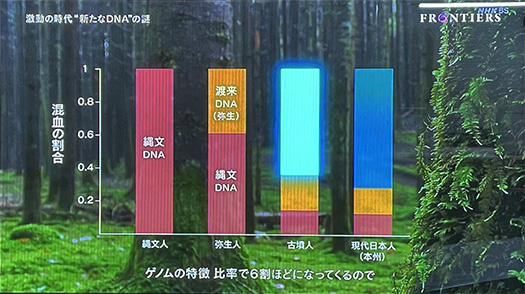
どうも兵庫県についての大騒ぎが伝わってきてすごいですね。一般メディアはあんまり見ていないけれど、youtuveなどの動画メディアでも再生数の多さは際だっている。その事件内容については報道でしか知りようがないのですが、ここまでの「情報ジャック」ぶりを見ていると、一種の社会現象レベル。大衆社会というのはカタルシスを求めるのが自然な趨勢なので、この状況がどんなふうに社会に変化を加えていくのか、そっちにも興味を持ちますね。
さて、時事・ニュースなどで一般メディア接触はほとんどないのですが、夫婦での食事時にバックグラウンドとしてわたしが興味を持つ放送内容のテレビ番組を、カミさんが録画収録してくれるものを見ることが楽しみです。火野正平の自転車ツアーなど、傾向としてはNHKBSの番組が多い。
そういうなかで一昨日放送されたヤツで「日本人とは何者なのか?」というのがあった<番組タイトルは記憶なので、不正確かも>。歴史や民俗が興味分野の大きな領域であるわたしをよく把握してくれていることに感謝しつつ、このテーマは最後まで一気に観てしまった。
NHK受信料はきちんと払っているので一定の許諾はあり得るだろう(笑)と考え、というかそれ以上に知的好奇心を強く刺激されたので、この番組画面ショットを収めていました。
タイトル通り「日本人とは何者なのか?」というテーマの極限的事実探究。縄文人のDNA解析という最新知見が解明されてきたという。それは東南アジアにまっすぐ到達していた出アフリカの人類グレートジャーニーの流れの一部が海岸線に沿って北上し、ほぼ陸続きだった日本列島に約1000人程度の規模で3万年以上前に移動してきたということを証明しているとのこと。
この縄文の人びとは非常に「行動的」な好奇心優勢型だという推論も紹介されていた。最新のDNA解析の進歩はまことにすごいと感動させられていた。
そういう縄文の世が日本列島で継続し独自発展したのには、その後の「縄文海進」によって大陸と四周が海で大陸と隔絶していったことが大きいことが理解できる。
しかしその隔絶を超えて弥生の農耕文化DNAが積層していって、さらに「古墳時代」になって大陸からの移住民たちが大量に「東アジアのフロンティア」としての日本列島にDNA積層していったのだということ。古墳時代人に至って、ほぼ現代人と同様のDNAが形成されてきたというのですね。
いやはやまことに面白い発見で、研究領域最先端ではこうした事実のインパクトが今後すさまじい「見直し」を呼んでいくと思えた。わたしの住まい民俗探究にも根底的刺激。う〜む。
English version⬇
NHK program “Where did the Japanese come from?” The Latest Genome Analysis
The latest research impact on my life’s work of exploring the folklore of Japanese homes, and the results of DNA analysis are stimulating. The results of the DNA analysis are stimulating.
Hi, it’s amazing to see what all the fuss is about Hyogo Prefecture. I haven’t seen much in the general media, but the number of views on youtuve and other video media is outstanding. I can only find out about the details of the incident through news reports, but seeing the “information hijacking” that has gone on to this point, it is a kind of social phenomenon. Since the natural tendency of mass society is to seek catharsis, it will be interesting to see how this situation will change society.
Although I have little contact with the general media in terms of current events and news, I look forward to watching TV programs that interest me as background material, which my wife records for me during our dinner time together. The programs tend to be NHKBS programs, such as Shohei Hino’s bicycle tour.
Among them, there was one that aired the day before yesterday, called “Where Do the Japanese Come From? The title of the program is from memory, so it may be inaccurate. Thanks to the fact that history and folklore are my major areas of interest, I was able to watch this program all the way through to the end.
Thinking that since I pay my NHK subscription fee properly, I would have a certain amount of permission (lol), or rather more than that, my intellectual curiosity was strongly stimulated, I had to include a screen shot of this program.
As the title suggests, “Where did the Japanese come from?” is an extreme factual exploration of the theme “Where did the Japanese come from? The latest findings, DNA analysis of the Jomon people, have been elucidated, he said. It proves that a part of the Great Journey of the Exo-African humans, which had reached straight to Southeast Asia, migrated northward along the coastline to the Japanese archipelago, which was almost land-locked, about 1,000 people strong, more than 30,000 years ago.
He also introduced the inference that these Jomon people were very “active” and curiosity-driven. I was impressed by the latest progress in DNA analysis.
It is understandable that the Jomon period continued and developed uniquely in the Japanese archipelago, largely due to the subsequent “Jomon Kaijin” (Jomon sea expansion), which separated the continent from the mainland on all four sides by the sea.
However, beyond this separation, the DNA of the Yayoi agricultural culture was layered, and furthermore, in the Kofun period, a large number of immigrants from the continent layered their DNA in the Japanese archipelago as the “frontier of East Asia”. The Kofun period people have formed DNA that is almost the same as that of modern humans.
This is a very interesting discovery, and I believe that the impact of such a fact at the cutting edge of the research field will bring about a tremendous “review” in the future. It is also a fundamental stimulus for my own exploration of housing folklore. Hmmm.
Posted on 9月 7th, 2024 by 三木 奎吾
Filed under: 日本社会・文化研究







コメントを投稿
「※誹謗中傷や、悪意のある書き込み、営利目的などのコメントを防ぐために、投稿された全てのコメントは一時的に保留されますのでご了承ください。」
You must be logged in to post a comment.